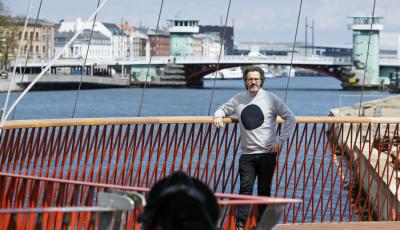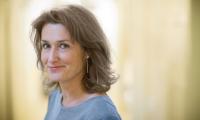Artist Olafur Eliasson
Danish-Icelandic artist Olafur Eliasson (born 1967) works in a wide range of media, including installation, painting, sculpture, photography, and film.
About the artist
Eliasson’s projects in public space include:
- Green river, realised in various cities between 1998 and 2001
- The New York City Waterfalls, 2008
- Your rainbow panorama, a 150-metre circular, coloured-glass walkway situated on top of ARoS Museum in Aarhus, Denmark, 2011
- The crystalline facades of the Harpa Reykjavik Concert Hall and Conference Centre (in collaboration with Henning Larsen Architects), 2005–11
- Cirkelbroen (The circle bridge), Copenhagen, Denmark, 2015
Danish-Icelandic artist Olafur Eliasson (born 1967) works in a wide range of media, including installation, painting, sculpture, photography, and film.
Since 1997, his critically acclaimed solo shows have appeared in major museums around the world, such as the Museum of Modern Art, New York; Tate Modern, London; Louisiana Museum of Modern Art, Humlebæk, Denmark; and the Venice Biennale.
In 2003, his hugely popular The weather project, in the Turbine Hall of Tate Modern, London, was seen by more than two million people.
Studio in Berlin
Established in 1995, his Berlin studio today numbers about eighty craftsmen, specialised technicians, architects, archivists, administrators, and cooks. They work with Eliasson to experiment, develop, and produce artworks and exhibitions, as well as to archive and communicate his work, digitally and in print.
In addition to realising artworks in-house, the studio contracts structural engineers and other specialists and collaborates worldwide with cultural practitioners, policymakers, and scientists. It regularly hosts workshops and events in order to further artistic and intellectual exchanges with people and institutions outside the art world.
Eliasson's other projects
From 2009 to 2014, Eliasson led the Institut für Raumexperimente (Institute for Spatial Experiments), a five-year experiment in arts education affiliated with the Berlin University of the Arts. Eliasson is currently adjunct professor at the Alle School of Fine Arts and Design in Addis Ababa, Ethiopia.
Together with engineer Frederik Ottesen, Eliasson founded the social business Little Sun in 2012. The global project produces and distributes the Little Sun solar lamp for use in off-grid communities and spreads awareness about the need to expand access to sustainable energy to all.
Eliasson lives and works in Copenhagen and Berlin.

Artist statement
Olafur Eliasson:
Cirkelbroen celebrates pedestrians. It reflects the daily life and intimacy that you find around the canal in the Christianshavn neighbourhood, its houseboats and sailing boats, the unique life on the ramparts. Copenhagen’s harbour was once a centre of maritime activity, and Cirkelbroen is a testimony to that history. While working on the bridge, I remembered the fishing boats I saw as a child in Iceland. In the harbour, the boats were often moored right next to each other, and it sometimes seemed that you could even cross the harbour just by walking from boat to boat.
The bridge is made of five circular platforms, and it contributes to a larger circle that will form a pedestrian route around Copenhagen Harbour, where people – cycling, running, walking – can see the city from a very different perspective. As many as 5,000 people will cross this bridge each day. I hope that these people will use Cirkelbroen as a meeting place, and that the zigzag design of the bridge will make them reduce their speed and take a break. To hesitate on our way is to engage in bodily thought. I see such introspection as an essential part of a vibrant city.
In Copenhagen, progress has been made in thinking about what constitutes quality in urban space and about the atmosphere of a space. Obviously, one cannot plan atmosphere, as it is co-produced by the people who use the space, but it is possible to nurture an atmosphere, to allow it to grow. As an artist, I work with abstract and emotional qualities, so this is where, I believe, art can play a role. I’m convinced that politicians, urban planners, and developers need to expand their toolbox by bringing in what I would call creative reality producers – artists, social scientists, sociologists, anthropologists, historians, dancers, poets, environmental activists, and philosophers – to rethink urban spaces.
In Denmark, there is a strong tradition of focusing on inclusion, on accepting the other – welcoming ideas that we have not yet had, people we have not yet met, and unpredictable encounters. It’s something we all have to work on together, and one way of addressing this is in how we plan public space. Cirkelbroen, I hope, will contribute to improving the quality of life and the development of a hospitable and inclusive city.
